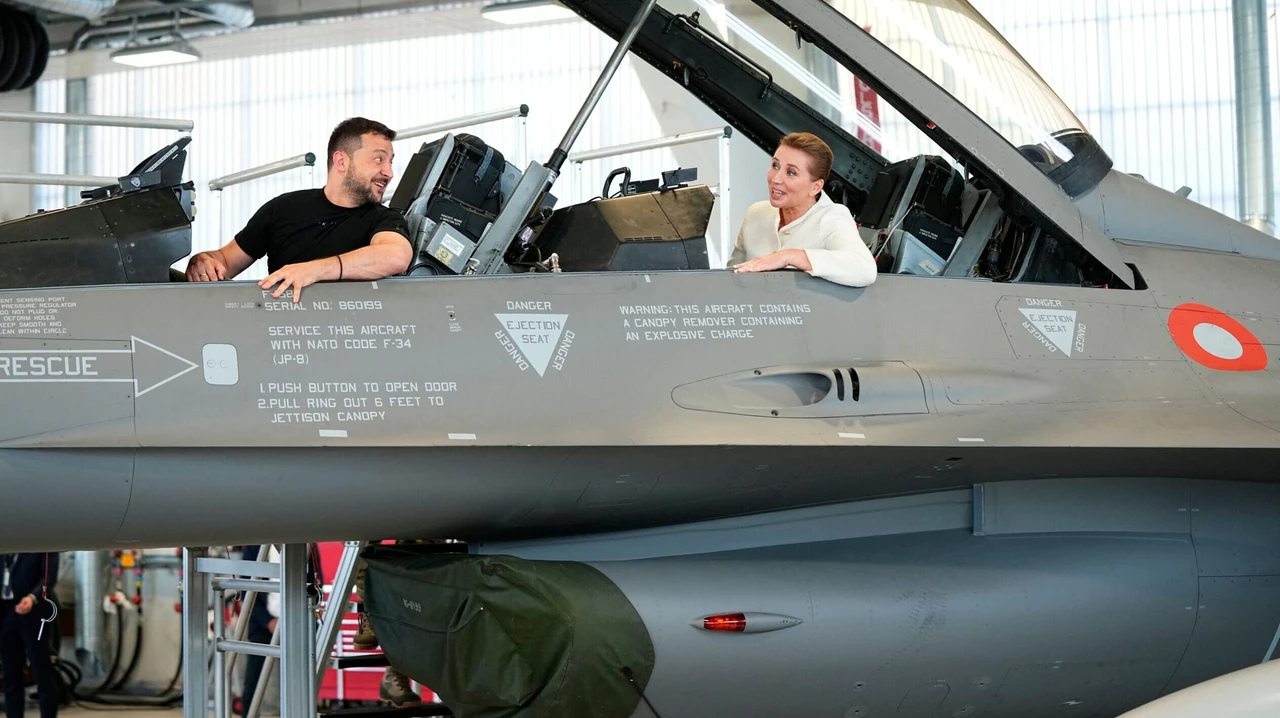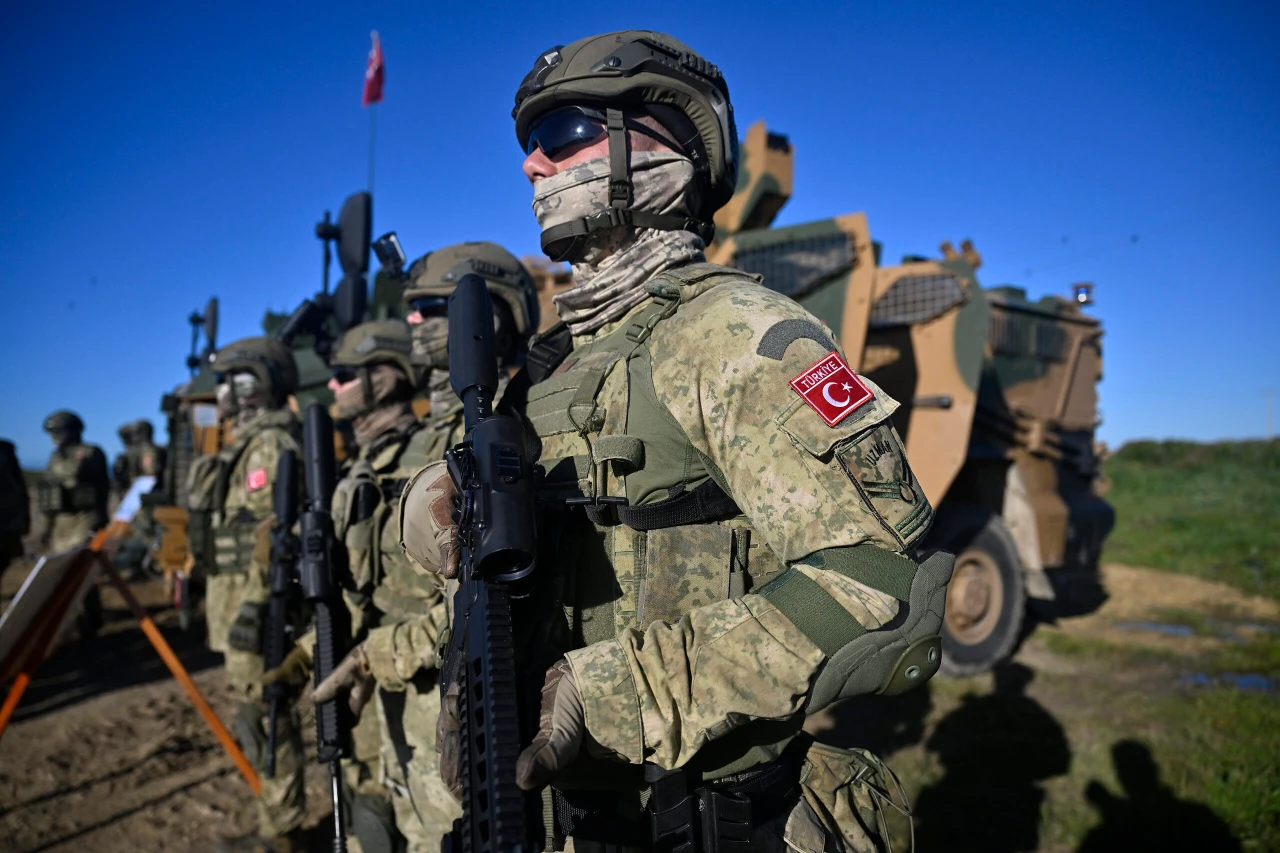First batch of F-16s arrive in Ukraine
 Ukrainian President Volodymyr Zelensky and Danish Prime Minister Mette Frederiksen react as they sit in a F-16 fighter jet in the hangar of the Skrydstrup Airbase in Vojens, northern Denmark (Photo via Getty Images)
Ukrainian President Volodymyr Zelensky and Danish Prime Minister Mette Frederiksen react as they sit in a F-16 fighter jet in the hangar of the Skrydstrup Airbase in Vojens, northern Denmark (Photo via Getty Images)
The first batch of long-awaited F-16 jets has arrived in Ukraine, according to Lithuania’s Foreign Minister Gabrielius Landsbergis and a U.S. official on Wednesday. Kyiv stated that these jets will play a crucial role in rebuilding its depleted air force.
“F-16s in Ukraine. Another impossible thing turned out to be totally possible,” Landsbergis said on X, formerly known as Twitter.
How many F-16’s will be delivered?
Ukrainian F-16s are now being sourced from a multinational European consortium led by Denmark and the Netherlands.
As of the latest count, approximately 85 F-16AM/BM jets have been committed to Ukraine. This includes 24 from the Netherlands, 19 from Denmark, and 12 from Norway, with Norway also providing 10 additional jets for spare parts. Belgium has pledged 30 jets, and Greece is being considered as a potential source of more fighters, specifically the F-16C/D Block 30 version.
Which weapons will be used by F-16’s?
- AIM-7 Sparrow: Ukraine is now using AIM-7 Sparrow and RIM-7 Sea Sparrow missiles with their SA-11 ‘Buk’ mobile air defense systems, as their stock of SAM missiles depletes.
- AGM-84 Harpoon: Ukraine has had ground-launched Harpoon anti-ship missiles for months, with a range of around 100 kilometers. However, deploying these missiles on tactical aircraft like the F-16 could significantly enhance their effectiveness. This would allow the F-16s to serve as both targeting and striking platforms, potentially further degrading Russia’s already weakened Black Sea Fleet.
- Miniature Air Launched Decoy (MALD): ADM-160 MALD missiles are believed to be in use in Ukraine, potentially alongside Storm Shadow missile attacks as decoys to confuse Russian air defense systems. Integrated with the F-16, MALD could play a crucial role in supporting standoff strikes and weakening Russia’s air defenses.
- Advanced Precision Kill Weapon System (APKWS): These laser-guided rockets based on the 70mm Hydra. It provides a highly accurate, low-yield solution for engaging moving vehicles or troops, including those in windows or doorways. APKWS is already in service in Ukraine in its ground-launched form.
- JDAM-ER/JDAM: Ukraine is already using JDAM-ERs, which are JDAMs equipped with range-extending wing kits, against Russian targets. The addition of F-16s will enable more dynamic deployment of these weapons.
- IRIS-T: The IRIS-T (also known as AIM-2000) is a short-to-intermediate-range infrared-guided air-to-air missile that can replace or enhance the AIM-9X. Already in use with Ukraine through IRIS-T SLM ground-based air defense systems, it has proven highly effective against low-flying drones and cruise missiles. The IRIS-T also offers short-range high-off-boresight (HOBS) capabilities and has an extended range for its class, providing some beyond-visual-range engagement options.
- AIM-9X: The AIM-9X offers Ukraine a powerful short-range air-to-air missile, ideal for use with F-16s equipped with Joint Helmet Mounted Cueing Systems (JHMCS) for high off-boresight (HOBS) engagements. Even without JHMCS, the AIM-9X significantly enhances the F-16s’ capabilities, especially for defending against drones and cruise missiles.
- AIM-9 Sidewinder: Canada is supplying AIM-9 missiles to Ukraine, likely the AIM-9X variant, for use with the NASAMS air defense system. The AIM-9X is a key munition for NASAMS and would be highly effective against short-range, low-flying threats such as drones and cruise missiles, which Russia deploys daily.
- GBU-53/B Small Diameter Bomb (SDB): SDB has already been cleared for use in Ukraine via the Ground-Launched SDB (GLSDB) system, of which the exact status remains unclear. But SDB will be a critical weapon for Ukraine’s F-16s due to its accuracy, standoff range, and ability to strike semi-hardened static targets.
- AGM-88 High-speed Anti-Radiation Missile (HARM): The F-16 will be able to use this weapon far more effectively than how it is currently being employed by Ukraine’s Soviet-designed tactical aircraft. This will mark a major enhancement in capability and a big threat increase to many Russian air defense systems deployed in conflict areas.
- AIM-120 AMRAAM: The AIM-120 AMRAAM is already in use in Ukraine through its NASAMS air defense systems, where they are likely employing AIM-120A/B variants for now. It is highly probable that Ukraine will also receive AMRAAMs for its F-16s, enhancing their air-to-air combat capabilities.
In addition to the weapons already in use or expected to be deployed, such as AIM-120 AMRAAMs and AIM-9Xs, Ukraine could also receive Paveway laser-guided bombs, AGM-65 Maverick air-to-ground missiles, and other advanced munitions from its allies.
Will it change things on ground?
With the F-16s, Ukraine will achieve greater efficiency compared to its existing Soviet-era aircraft. The F-16s are fully compatible with NATO systems, which should minimize integration issues and enhance operational effectiveness.
The F-16s’ integration eliminates the need for additional vehicles to transfer data between munitions and aircraft, ensuring high-level communication between the pilot and the munitions. Although Ukraine still uses many Soviet-era air defense systems and equipment, the F-16s’ compatibility with NATO systems will enhance Ukraine’s network-centric operational capabilities and improve coordination with existing NATO-compatible assets.
The F-16s could be a game changer in the Ukraine-Russia war, but it’s important to remember that Ukraine is new to operating these aircraft. The platform’s effectiveness is expected to grow as Ukrainian forces gain more experience with it.
The missions assigned to the F-16s will significantly impact their performance. The F-16s are versatile, capable of conducting SEAD/DEAD (Suppression/Destruction of Enemy Air Defenses), CAP (Combat Air Patrol), air-to-air, and air-to-ground operations. Additionally, the specific pods and equipment provided to Ukraine could be crucial in determining the effectiveness of these missions.
The F-16s have the potential to change the current situation in Ukraine. However, their impact will largely depend on how effectively Ukraine adapts to and utilizes these platforms.



